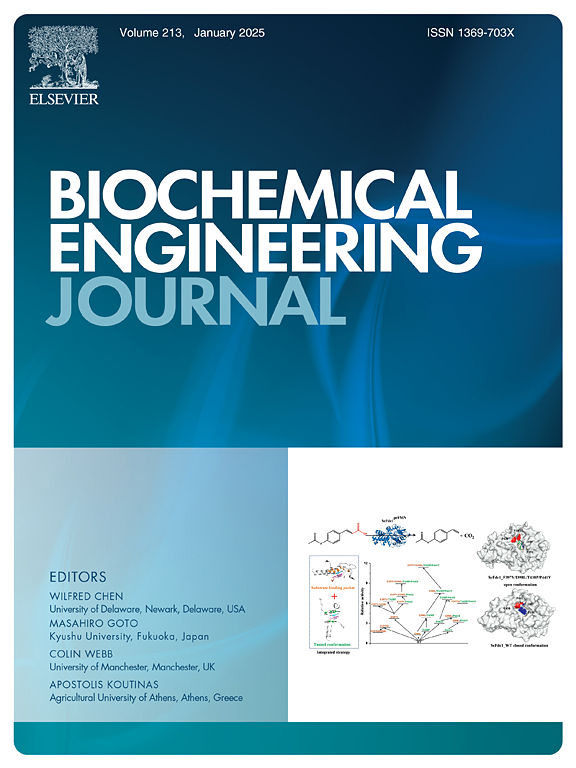不同产碳酸酐菌固存CO2的比较及机理
IF 3.7
3区 生物学
Q2 BIOTECHNOLOGY & APPLIED MICROBIOLOGY
引用次数: 0
摘要
随着二氧化碳的快速排放加速全球变暖,二氧化碳地质封存因其巨大的封存场地和安全的长期封存能力而受到广泛关注。碳酸酐酶(CA)能加速CO2水化反应,促进碳酸钙的沉淀。但CA热稳定性差,净化成本高,因此有必要直接利用产CA菌在高温环境下进行CO2地质封存。本文从地质含盐含水层中筛选耐中高温产钙菌株,并与粘液芽孢杆菌进行比较,揭示其耐中高温的原因。随后,研究了两菌株在不同温度下的CO2固溶能力。在50℃条件下,地衣芽孢杆菌S5的CO2固存能力最高,反应10天后达到127 mM,比地衣芽孢杆菌CICC 10101和粘液芽孢杆菌分别高出26.8 %和24.9 %。最后,分析了不同产ca菌对CO2的固存机理。在高温条件下,地衣芽胞杆菌S5的酶活性较高,更有利于CO2转化为离子态。本研究为部分中高温情景下的CO2固存提供了理论支持。本文章由计算机程序翻译,如有差异,请以英文原文为准。
Comparison and mechanism of CO2 sequestration by different carbonic anhydrase producing bacteria
With the rapid emission of CO2 accelerating global warming, CO2 geological storage has attracted wide attention due to its huge storage site and safe long-term storage capacity. Carbonic anhydrase (CA) can accelerate CO2 hydration reaction and promote calcium carbonate precipitation. However, CA has poor thermal stability and high purification cost, so it is necessary to directly use CA producing bacteria for CO2 geological storage under high temperature environment. In this paper, CA-producing bacterial strains resistant to medium and high temperature was screened from geological saline aquifers and compared with Bacillus mucilaginosus to reveal the reason for its resistance to medium and high temperature. Subsequently, the CO2 dissolution sequestration capabilities of the two strains were explored at different temperatures. At 50℃, the CO2 sequestration capacity of Bacillus licheniformis S5 was the highest, and reached 127 mM after 10 days of reaction, which was 26.8 % and 24.9 % higher than that of B. licheniformis CICC 10101 and B. mucilaginosus. Ultimately, the CO2 sequestration mechanism of different CA-producing bacteria was analyzed. Under high temperature conditions, the enzyme activity of the unit-living bacteria of B. licheniformis S5 was higher, which was more conducive to the conversion of CO2 into ionic state. This study provides theoretical support for CO2 sequestration in some medium and high temperature scenarios.
求助全文
通过发布文献求助,成功后即可免费获取论文全文。
去求助
来源期刊

Biochemical Engineering Journal
工程技术-工程:化工
CiteScore
7.10
自引率
5.10%
发文量
380
审稿时长
34 days
期刊介绍:
The Biochemical Engineering Journal aims to promote progress in the crucial chemical engineering aspects of the development of biological processes associated with everything from raw materials preparation to product recovery relevant to industries as diverse as medical/healthcare, industrial biotechnology, and environmental biotechnology.
The Journal welcomes full length original research papers, short communications, and review papers* in the following research fields:
Biocatalysis (enzyme or microbial) and biotransformations, including immobilized biocatalyst preparation and kinetics
Biosensors and Biodevices including biofabrication and novel fuel cell development
Bioseparations including scale-up and protein refolding/renaturation
Environmental Bioengineering including bioconversion, bioremediation, and microbial fuel cells
Bioreactor Systems including characterization, optimization and scale-up
Bioresources and Biorefinery Engineering including biomass conversion, biofuels, bioenergy, and optimization
Industrial Biotechnology including specialty chemicals, platform chemicals and neutraceuticals
Biomaterials and Tissue Engineering including bioartificial organs, cell encapsulation, and controlled release
Cell Culture Engineering (plant, animal or insect cells) including viral vectors, monoclonal antibodies, recombinant proteins, vaccines, and secondary metabolites
Cell Therapies and Stem Cells including pluripotent, mesenchymal and hematopoietic stem cells; immunotherapies; tissue-specific differentiation; and cryopreservation
Metabolic Engineering, Systems and Synthetic Biology including OMICS, bioinformatics, in silico biology, and metabolic flux analysis
Protein Engineering including enzyme engineering and directed evolution.
 求助内容:
求助内容: 应助结果提醒方式:
应助结果提醒方式:


